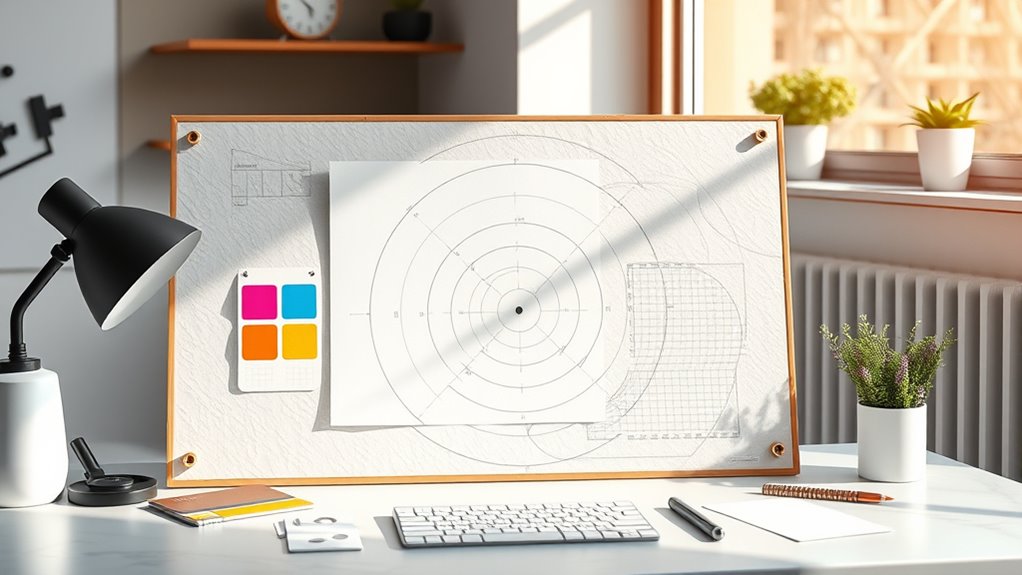Applying the Golden Ratio to your layouts helps create balanced and visually pleasing designs by using proportions around 1.618, found in nature and art. You can incorporate it by dividing your space into sections based on this ratio, adjusting element sizes, spacing, and placement accordingly. This guarantees harmony and guides the viewer’s eye smoothly through your work. Continue exploring, and you’ll discover how to achieve even more unified, professional results with these principles.
Key Takeaways
- Use the ratio (about 1.618) to determine proportions for layout elements like grids, images, and text blocks.
- Divide your layout into sections based on the Golden Ratio to create balanced and harmonious compositions.
- Position focal points and key elements along lines or intersections derived from the ratio for natural visual flow.
- Apply the Golden Ratio to font sizes, line heights, and spacing to enhance readability and aesthetic consistency.
- Utilize design tools and templates with built-in Golden Ratio guides to streamline implementation and ensure precision.
Understanding the Fundamentals of the Golden Ratio
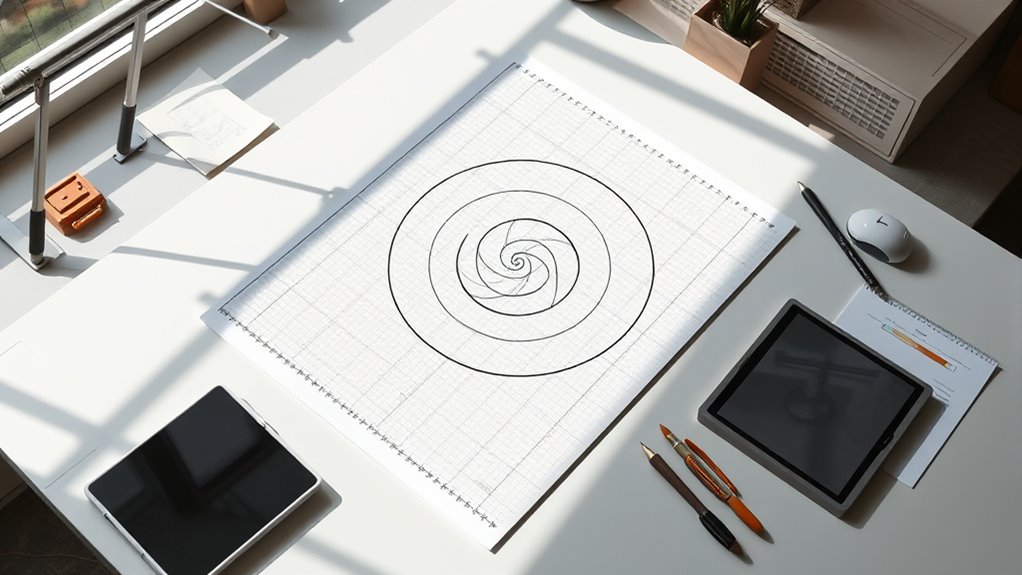
The Golden Ratio is a mathematical principle that describes a specific proportion found in nature, art, and architecture. It’s often represented by the Greek letter phi (φ) and approximately equals 1.618. When you divide a line into two parts so that the whole length divided by the longer part equals the longer part divided by the shorter part, you’ve applied the Golden Ratio. This creates a balanced, harmonious proportion that’s naturally pleasing to the eye. Understanding this concept helps you recognize how these proportions appear in various designs and structures. It’s not just about aesthetics; it also influences how we perceive beauty and order. Grasping the fundamentals of the Golden Ratio gives you a solid foundation for applying it effectively in your layouts. Recognizing natural proportions like the Golden Ratio can also inform your design choices, making your layouts more engaging and visually appealing. Additionally, incorporating these proportions can improve the overall visual harmony of your projects, leading to more professional and balanced results. In many cultural and artistic contexts, the Golden Ratio has been used to create compelling compositions that resonate with viewers. Understanding mathematical relationships such as the Golden Ratio enhances your ability to craft aesthetically pleasing and harmonious designs. Recognizing these proportions in honeycomb structures, for example, illustrates how nature employs the Golden Ratio for efficiency and strength.
Identifying the Golden Ratio in Nature and Art

Since the Golden Ratio naturally appears in various forms, learning to identify it in both nature and art can greatly enhance your design intuition. In nature, look for spirals in shells, sunflower heads, and galaxies. These patterns often follow the ratio, creating pleasing proportions. Understanding natural patterns can help you see how these ratios manifest organically. Recognizing these examples helps you see how balance and harmony emerge naturally. When you observe the world around you, focus on shapes, arrangements, and proportions that seem intuitively pleasing or balanced. This awareness can also improve your ability to create aesthetic compositions that resonate visually. Additionally, exploring natural fractal patterns can deepen your appreciation for how complex yet harmonious structures develop in nature. Over time, you’ll start noticing the Golden Ratio’s subtle presence, making it easier to incorporate its principles into your own layouts. Additionally, understanding bioluminescent phenomena can inspire organic and luminous design elements.
Calculating the Golden Ratio for Your Layouts
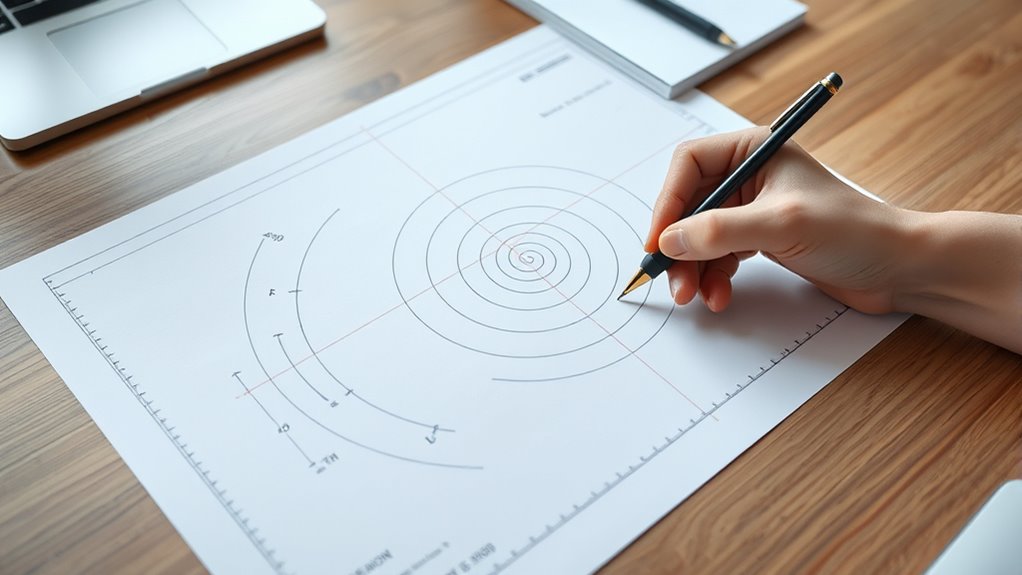
To incorporate the Golden Ratio into your layouts, you need to understand what the ratio is and how to calculate it. You can use simple mathematical tools or formulas to find the precise measurements that follow this principle. Applying these calculations to your design elements will help you create more balanced and aesthetically pleasing compositions.
Understanding the Ratio
Have you ever wondered how to determine the perfect proportions for your layouts? The key is understanding the Golden Ratio, roughly 1.618. To find this, divide a line into two parts so that the whole length divided by the longer part equals the longer part divided by the shorter part. This simple calculation creates harmony and balance. Visualize it with this table:
| Total Length | Larger Segment | Smaller Segment |
|---|---|---|
| 100 units | 61.8 units | 38.2 units |
| 200 units | 122.9 units | 77.1 units |
| 150 units | 92.7 units | 57.3 units |
| 250 units | 154.1 units | 95.9 units |
Mastering this ratio allows you to craft layouts that naturally feel right to the eye.
Using Mathematical Tools
Calculating the Golden Ratio for your layouts involves using simple mathematical tools like a calculator or spreadsheet. To find the ratio, start with the number 1, then add 1 to get 2, and divide 2 by 1 to get approximately 1.618. This number is the core of the Golden Ratio. You can also use spreadsheets to generate this ratio by inputting formulas, making adjustments easier. For example, if you’re designing a layout and want a specific element to follow the ratio, measure its size and divide it by the total width or height. This helps guarantee your proportions align with the Golden Ratio, creating pleasing and balanced designs. Mathematical precision makes applying these calculations straightforward, even if you’re not a math expert. Additionally, understanding how to incorporate well-being tips can enhance the aesthetic and functional harmony of your designs. Incorporating aesthetic principles based on the Golden Ratio can further improve the visual appeal and overall balance of your layouts. Being aware of design fundamentals can also help you create more harmonious compositions. For optimal results, consider how nutritional benefits of vegetable juices can inspire your design choices, emphasizing harmony and natural flow.
Applying to Design Elements
Once you’ve mastered the mathematical basics, applying the Golden Ratio to your design elements becomes straightforward. To do this, start by dividing your layout into sections based on the ratio, such as 1:1.618. For example, set your header’s height to 61.8% of the total page height. When designing images or text blocks, use the ratio to determine their dimensions, creating natural visual harmony. You can also apply it to the placement of key elements, ensuring focal points fall along lines or intersections derived from the ratio. Using grid systems or rulers, measure these proportions precisely. Incorporating the Golden Ratio into your design elements guides the viewer’s eye smoothly and creates a balanced, aesthetically pleasing composition. Additionally, applying principles like the Private Placement Memorandum can help ensure your layout aligns with effective communication strategies. Understanding visual balance is essential for creating layouts that are both attractive and functional, which can be reinforced by the Golden Ratio. Recognizing how spatial harmony influences perception can further enhance the overall effectiveness of your design.
Applying the Golden Ratio to Composition and Balance

Applying the Golden Ratio to composition and balance involves deliberately placing elements so that their proportions align with this timeless ratio, creating a sense of harmony and visual appeal. To do this effectively, consider these key techniques:
- Position focal points at the ratio points to guide viewers’ eyes naturally.
- Balance large and small elements according to the ratio to avoid clutter or emptiness.
- Use the Golden Spiral to arrange elements in a flowing, dynamic way.
- Ensure visual weight is evenly distributed by aligning major components with the ratio, fostering stability.
Using the Golden Ratio in Grid Systems and Spacing
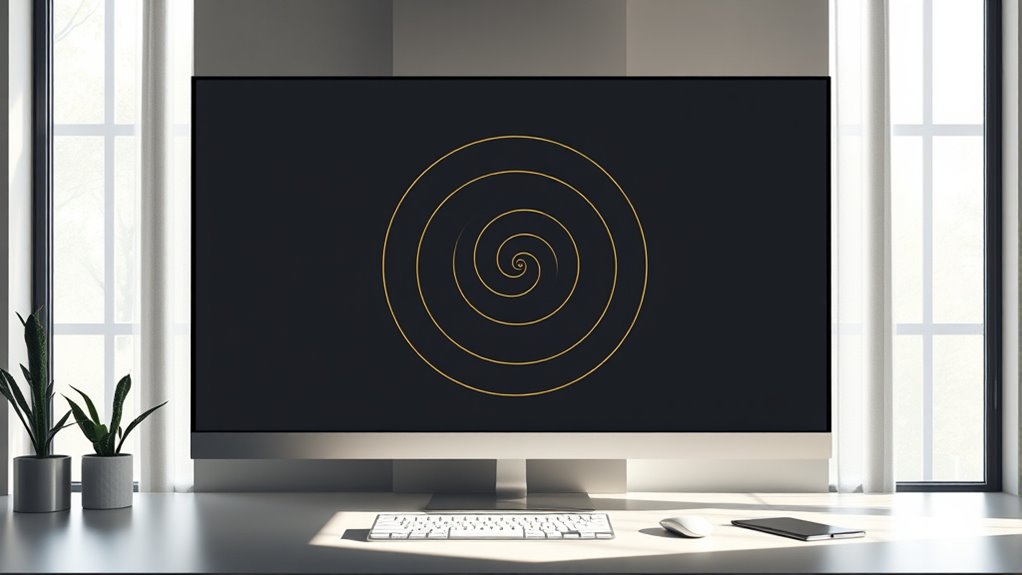
You can create more balanced layouts by applying the Golden Ratio to your grid systems and spacing. Using these proportions helps guarantee that elements feel naturally aligned and pleasing to the eye. Incorporating Golden Ratio-inspired spacing guides your design toward harmony and visual flow.
Harmonious Proportions in Grids
In grid design, the Golden Ratio offers a natural way to create balanced and visually appealing layouts. It helps you establish proportions that feel intuitive and harmonious, guiding the viewer’s eye smoothly across your design. To incorporate this effectively, consider these key points:
- Use the ratio to determine the height and width of grid columns and rows.
- Apply the Golden Ratio to divide sections within your grid, ensuring each part feels naturally connected.
- Adjust spacing between elements based on the ratio to achieve a balanced feel.
- Align key visual elements along the ratio lines for emphasis and flow.
Spacing With Golden Ratios
Have you ever noticed how well-balanced designs naturally guide your eye? That’s the power of using golden ratios in spacing. When you incorporate these ratios into your grid systems, spacing feels more harmonious and intuitive. For example, instead of equal gaps, you might use ratios like 1.618 or 0.618 to determine padding, margins, or gutter sizes. This subtle variation creates a rhythm that feels natural and pleasing. By applying the golden ratio to your spacing, you avoid clutter and improve readability. It helps direct attention smoothly across your layout without overwhelming. Whether you’re designing a website or a print spread, using these ratios in your spacing enhances visual flow and balance. It’s a simple yet powerful way to elevate your designs effortlessly.
Incorporating the Golden Ratio Into Typography and Text Blocks
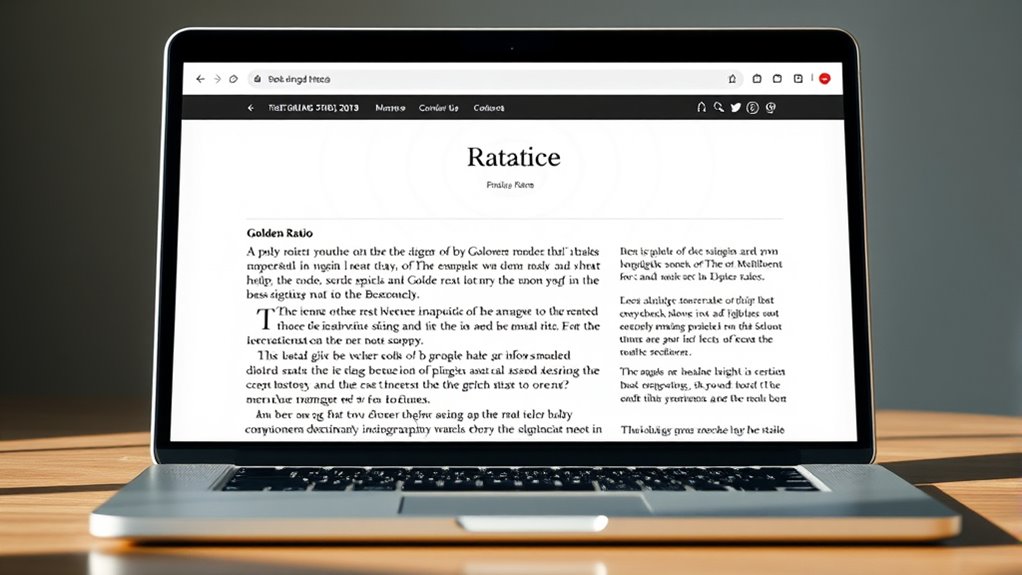
Incorporating the Golden Ratio into typography involves carefully selecting font sizes, line heights, and spacing that adhere to its proportions, creating a harmonious flow within your text blocks. To do this effectively, consider these key points:
- Use a font size ratio close to 1:1.618 between headings and body text to establish visual hierarchy.
- Apply the Golden Ratio to line height, ensuring enough space for readability without overwhelming the text.
- Adjust paragraph spacing to reflect the proportions, maintaining balance and consistency.
- Align margins and padding with the ratio to create a cohesive aesthetic that guides the reader naturally.
Tools and Resources for Implementing the Golden Ratio
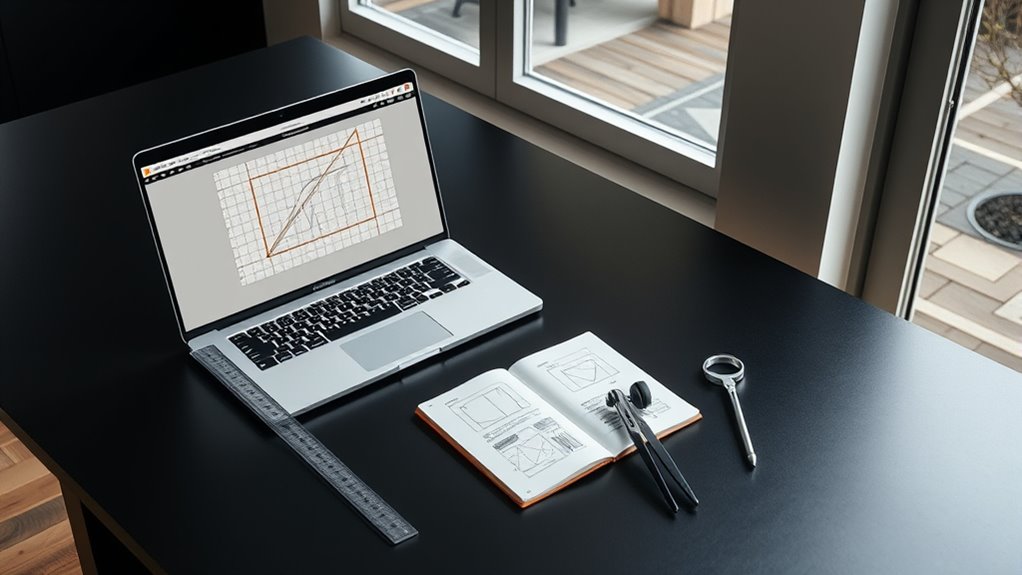
To effectively implement the Golden Ratio in your layouts, you can leverage a variety of tools and resources designed to simplify the process. Many design software programs, like Adobe Photoshop and Illustrator, include built-in guides and grids based on the Golden Ratio, making it easy to align elements accurately. Additionally, online calculators and apps, such as Golden Ratio calculators, help you quickly determine ideal proportions without manual calculations. Templates and pre-designed grids are also available to provide instant frameworks for your projects. Educational resources, like tutorials and articles, deepen your understanding of applying the ratio effectively. Using these tools, you streamline your workflow, ensure consistency, and achieve harmonious, visually appealing layouts with confidence and precision.
Tips for Achieving Harmony and Visual Appeal With the Golden Ratio
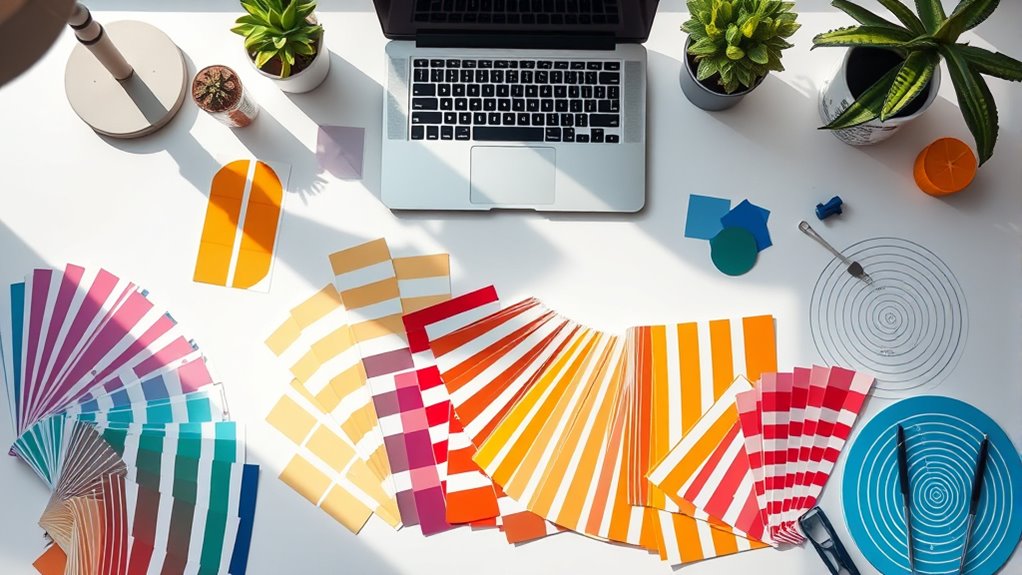
Using the right tools makes applying the Golden Ratio more straightforward, but achieving true harmony also depends on your design choices. To enhance visual appeal, focus on these key tips:
- Balance elements by distributing focal points according to the ratio, avoiding clutter.
- Use the Golden Spiral to guide the placement of images and text for natural flow.
- Keep spacing consistent, aligning margins and padding to reinforce harmony.
- Limit color palettes and fonts to create a cohesive look that emphasizes your layout’s structure.
Frequently Asked Questions
Can the Golden Ratio Be Applied to Digital and Print Media Effectively?
You might wonder if the Golden Ratio works well for digital and print media. It can be highly effective because it creates balanced, visually appealing designs that guide the viewer’s eye naturally. When you apply it thoughtfully, whether in layouts, images, or typography, it enhances aesthetics and readability. Just remember to adapt it to your specific project needs, ensuring your design feels harmonious without overusing the ratio.
Are There Common Mistakes to Avoid When Using the Golden Ratio in Design?
Some believe the golden ratio guarantees perfect design, but that’s not always true. When you use it, avoid forcing it into every element or ignoring your overall composition. Relying solely on the ratio can make designs feel rigid or unnatural. Instead, you should consider it as a guideline, blending it subtly into your layout. Balance the ratio with creativity and intuition for the most effective, visually appealing results.
How Flexible Is the Golden Ratio Across Different Design Styles?
You might wonder how adaptable the golden ratio really is across various design styles. It’s quite flexible because it offers a natural sense of harmony and balance that works in minimalistic, modern, or ornate designs. You can tweak its proportions to suit your aesthetic, making it a versatile tool. Remember, it’s a guideline, not a strict rule, so feel free to experiment and adapt it to fit your unique style.
What Software Tools Best Assist in Implementing the Golden Ratio?
Your quest for perfect design tools is nothing short of a treasure hunt. To implement the golden ratio seamlessly, you should explore software like Adobe Photoshop and Illustrator for precise grid overlays, or Canva for user-friendly, guided layouts. These tools help you incorporate the ratio effortlessly, transforming your designs from good to breathtaking. With the right software, you’ll master the golden ratio, elevating your layouts to legendary status.
How Do Cultural Differences Influence Perceptions of Harmony Using the Golden Ratio?
You might wonder how cultural differences shape perceptions of harmony with the golden ratio. Recognize that cultural backgrounds influence aesthetic preferences; some cultures may prioritize symmetry or vibrant colors over proportions. As you design, consider your audience’s cultural context, adapting your use of the golden ratio accordingly. By understanding these nuances, you guarantee your layouts resonate universally, creating a sense of harmony that feels natural and appealing across diverse viewers.
Conclusion
By applying the golden ratio, you craft layouts that feel natural and harmonious—like a Renaissance masterpiece in digital form. Think of it as your secret map, guiding your design journey through a labyrinth of chaos to clarity. With a little practice, you’ll wield this ancient ratio like a Jedi with a lightsaber, creating compositions that captivate and delight. Embrace the golden ratio, and watch your designs become timeless works of art—no DeLorean needed.
